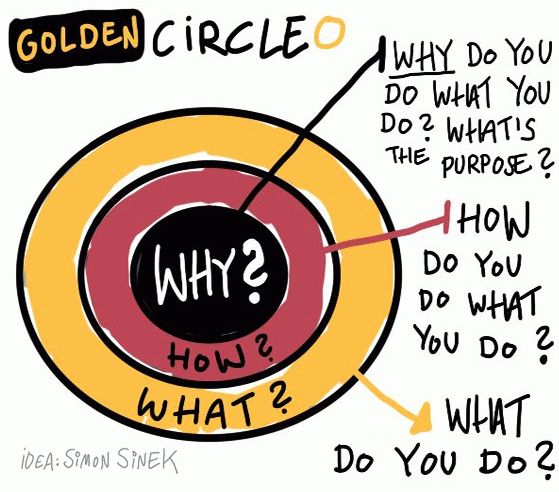Dance(Sports) – „Always start with WHY!“
At the beginning of an activity there is always the question of WHY. This assumption, based on the renowned concept of the business consultant and representative of the model the „Golden Circle“, Simon Sinek, shows the unconscious patterns of inspiring leadership, leaders, businesses, as well as private individuals on the successful examples, such as: Martin Luther King Jr., Steve Jobs, and many more. After an in-depth study of his works, philosophy and thoughts, it was a matter for me to transfer the business model of the „Golden Circle“ to the dancesport. However, this article is not intended to be presented for a discussion at the level of the content of a single movement (inner layer), as well as on the level of the form (outer layer) in only one movement action, but in this case, in the personal intrinsic motivation of each individual dancer for character development. It is intended to give an idea of why a few dancers inspire other people to act (or participate in their actions). „Act, think & communicate from the Inside Out“ – Simon Sinek
In the course of my teaching and coaching activities, I am increasingly bumped into the phenomenon of the stereotypical approach to dancesport, „I want to win“ (Ruud Vermey – Dancers approaching a competition performance with what might be called a „sport-attitude“ will dance to win, with a purposeful physical activity, fulfilling the act as perfectly as possible to elicit the best result), which lacks a differentiated and individual personality induced self-disclosure. „WHY does somebody actually compete in dancing“ from the inside out. This should not call into question a sporting and competitive approach as an authentically transported decision-making feature, but rather raise the question in this context: „If everyone wants to transport that, what makes the difference?“
I want to see personalities on the dancefloor, no stereotypes!
This is why I ask myself provoking questions such as „WHY this partner?“, „WHY do you train every day?“ And „WHY should anyone be interested?
The flat statement of a person wanting to be the best in his sport, is not significantly different from the goals of many others and therefore brings only short-term emotional interest in many people. For this reason unfortunately often „the door is opened to the reputation“, but not to the human being itself. This suggests that one is more concerned with the image of the dancer, than with the human being itself, which ultimately makes him interchangeable at any time. And without transporting a WHY, one can also be replaced for the audience and the judge.
Other multifactorial reasons, such as the beginning of a competitive career based on parents‘ aspirations for success, the idealization of victorious couples, socio-cultural factors, etc., are just as legitimate, but precisely these status-oriented parameters are purely extraneous-induced and manifested experience qualities, which hinder the healthy development of an „individual movement intelligence“. You always go after the goal, because the given WHAT and HOW is more important than the fundamental WHY. It would be important to push the dancer, what the intrinsic motivation of dancing is and wether he or she can express these qualities in general. – The visible product of the inner motive.
„Individual movement intelligence“ = Situative sensorimotor adaptation to environmental conditions
The decisive factor in the development of this „individual movement intelligence“ is the creation of a self-directed vision, a character formation based not on purely external confirmation (judges, coaches, parents, friends, competitors), but on the discovery of one’s own inner self-worth. That what one believes in the innermost itself, other people will move! Otherwise one would be caught in a paradox, namely, the vision of improvement of self-confidence through dancesport in spite of purely subjective evaluation, in the same way as if one would think, that the gathering of Facebook friends leads to more honest popularity.
A comparison example of a WHY message:
From the outside to the inside:
I move faster and more aesthetically than the others (WHAT)
Because I train daily and plan my competitions consistently (HOW)
I will be the best. (WHY)
Or from the inside out:
For all that I do, my goal is to question the existing and to inspire and touch people in my own way. (WHY)
I know I reach people in the long term, because I constantly believe in my strengths and work on my weaknesses. (HOW)
That is why I will succeed. (WHAT)
Technical skills as a causal consequence of a disciplined, process-oriented and structured training to perfection – HOW you do, WHAT you do, have not been a limiting factor in high performance sports for a very long time, since only mental and sportpsychological components complete the qualities of a champion.
Of course this essay is just one of many models, and represents only my personal approach to education for a mature dancer personality.
With regard to the act of the dancer performance itself – WHAT you do – I again support the statement by Simon Sinek: „People don’t buy what you do, they buy why you do it.“ and appeal – as a value judge – to let go the perceived intuition, as the catalyst, for the qualitative interaction with other people, to reach and touch them. – „because sometimes the most dangerous animals for a human being are the butterflies in the belly.“


